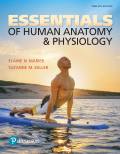
More than one choice may apply.
Which would lead to increased erythropoiesis?
a. Chronic bleeding ulcer
b. Reduction in respiratory ventilation
c. Decreased level of physical activity
d. Reduced blood flow to the kidneys
Introduction:
When oxygen level decreases in the blood, kidney produces a hormone named as erythropoietin that causes the stimulation of the bone marrow to produce more RBCs (red blood corpuscles). This process is known as erythropoiesis.
Answer to Problem 1MC
Correct answer:
Chronic bleeding ulcer, reduction in respiratory ventilation, and reduced blood flow to the kidney lead to increased erythropoiesis.
Explanation of Solution
Explanation for correct answers:
Option (a) is given as a chronic bleeding ulcer. Discontinuity or break in the membrane of an organ that prevents the organ from carrying out its normal function is known as an ulcer. After some time an untreated ulcer may transform into a chronic bleeding ulcer. An excessive loss of the blood leads to decrease in the oxygen level and this event triggers erythropoiesis. Hence, option (a) is correct.
Option (b) is given as a reduction in the respiratory ventilation. Reduction in the respiratory ventilation leads to lower oxygen level in the body that stimulates erythropoiesis, which increases the RBC count in the blood. Hence, option (b) is correct.
Option (d) is given as reduced blood flow to the kidneys. When blood flow reduces in the kidneys, it indicates low RBC count as well as low oxygen level in the body. To compensate for the normal oxygen transmission in the body, kidney produces a hormone called erythropoietin that induces the RBC production by stimulating the bone marrow. Hence, option (d) is correct.
Explanation for the incorrect answer:
Option (c) is given as decreased level of physical activity. During a physical activity, the body uses more oxygen to produce energy. This decreases the oxygen level in the blood and increases the production (erythropoiesis) of the RBCs in the body. A decreased level of physical activity has sufficient oxygen for energy purposes and does not induce erythropoiesis. So, it is an incorrect option.
Hence, option (c) is incorrect.
Thus, increased erythropoiesis is the result of chronic bleeding ulcer, reduction in the respiratory ventilation, and reduced blood flow to the kidneys.
Want to see more full solutions like this?
Chapter 10 Solutions
EBK ESSENTIALS OF HUMAN ANATOMY & PHYSI
- 1. In the following illustration of a phospholipid... (Chemistry Primer and Video 2-2, 2-3 and 2-5) a. Label which chains contain saturated fatty acids and non-saturated fatty acids. b. Label all the areas where the following bonds could form with other molecules which are not shown. i. Hydrogen bonds ii. Ionic Bonds iii. Hydrophobic Interactions 12-6 HICIH HICIH HICHH HICHH HICIH OHHHHHHHHHHHHHHHHH C-C-C-C-C-c-c-c-c-c-c-c-c-c-c-c-C-C-H HH H H H H H H H H H H H H H H H H H HO H-C-O H-C-O- O O-P-O-C-H H T HICIH HICIH HICIH HICIH HHHHHHH HICIH HICIH HICIH 0=C HIC -C-C-C-C-C-C-C-C-CC-C-C-C-C-C-C-C-C-H HHHHHHHHH IIIIIIII HHHHHHHH (e-osbiv)arrow_forwardAnswer this as a dental assistant studentarrow_forwardbuatkan judul skripsi tentang parasitologi yang sedang trendinharrow_forward
- Dental assistantarrow_forwardO Macmillan Learning Glu-His-Trp-Ser-Gly-Leu-Arg-Pro-Gly The pKa values for the peptide's side chains, terminal amino groups, and carboxyl groups are provided in the table. Amino acid Amino pKa Carboxyl pKa Side-chain pKa glutamate 9.60 2.34 histidine 9.17 1.82 4.25 6.00 tryptophan 9.39 2.38 serine 9.15 2.21 glycine 9.60 2.34 leucine 9.60 2.36 arginine 9.04 2.17 12.48 proline 10.96 1.99 Calculate the net charge of the molecule at pH 3. net charge at pH 3: Calculate the net charge of the molecule at pH 8. net charge at pH 8: Calculate the net charge of the molecule at pH 11. net charge at pH 11: Estimate the isoelectric point (pl) for this peptide. pl:arrow_forwardBiology Questionarrow_forward
- This entire structure (Pinus pollen cone) using lifecycle terminology is called what?arrow_forwardThis entire structure using lifecycle terminology is called what? megastrobilus microstrobilus megasporophyll microsporophyll microsporangium megasporangium none of thesearrow_forwardHow much protein should Sarah add to her diet if she gets pregnant? Sarah's protein requirements during pregnancy would be higher. See Hint B2. During calculations, use numbers rounded to the first decimal place. In your answer, round the number of grams to the nearest whole number. _______ g ?arrow_forward
- C MasteringHealth MasteringNu X session.healthandnutrition-mastering.pearson.com/myct/itemView?assignment ProblemID=17396422&attemptNo=1&offset=prevarrow_forwardMost people, even those who exercise regularly at low to average intensity (1 hour at the gym or a 2- to 3-mile walk several times per week), do not need an increased protein intake. What would be the protein needs of a man named Josh who exercises moderately and is the same age and size as Wayne? Josh is 5 ft, 8 in tall and weighs 183 lb. Round the number of grams to the nearest whole number. During calculations, use numbers rounded to the first decimal place. Because protein requirement is a range, please enter two numbers: lower and upper range values, respectively. Separate the lower and upper range values, in that order, by a comma. ___, ___ g ?arrow_forwardC MasteringHealth MasteringNu X session.healthandnutrition-mastering.pearson.com/myct/itemView?assignment ProblemID=17396422&attemptNo=1&offset=prevarrow_forward
 Medical Terminology for Health Professions, Spira...Health & NutritionISBN:9781305634350Author:Ann Ehrlich, Carol L. Schroeder, Laura Ehrlich, Katrina A. SchroederPublisher:Cengage Learning
Medical Terminology for Health Professions, Spira...Health & NutritionISBN:9781305634350Author:Ann Ehrlich, Carol L. Schroeder, Laura Ehrlich, Katrina A. SchroederPublisher:Cengage Learning- Essentials Health Info Management Principles/Prac...Health & NutritionISBN:9780357191651Author:BowiePublisher:Cengage





